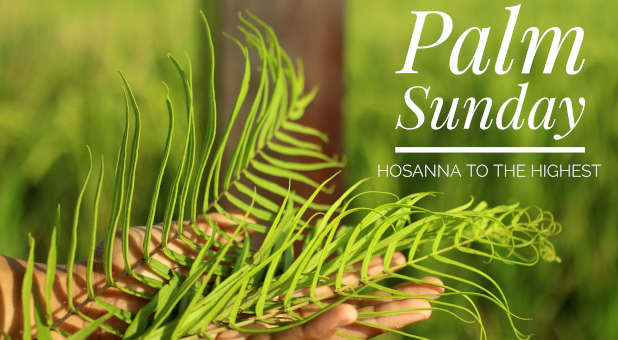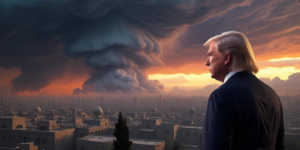The Prophetic Significance of Palm Branches This Sunday
It’s Palm Sunday, and you enter the church doors, dressed for the occasion. With a smile, a cheerful greeter hands you a palm branch before you enter the sanctuary.
If you are like me, you have probably wondered what the actual significance is behind the palm branch for this particular celebration day. While we all may be aware of the role that palm branches played in Jesus’ crucifixion, there are a lot of historical truths surrounding this important topic: the palm branch. So, why the palm branches? I would like to help answer that question and explain how it can be applied to our lives today.
The book of Zechariah describes how the King of the Jews would come onto the scene as the triumphant, victorious leader.
“Rejoice greatly, o daughter of Zion! And cry aloud, O daughter of Jerusalem! See, your King is coming comes to you; He is righteous and able to deliver; He is humble and riding on a donkey, a colt, the offspring of a donkey” (Zech. 9:9).
It is no secret how the Jewish people would see their newly revealed king one day. As Jesus was preparing to enter Jerusalem, the Jewish people were looking for the one who would deliver them from the Roman Empire. They no longer wanted the corrupt Roman rulers to dictate their Jewish lives; they were looking for the coming Messiah.
When you connect Zechariah 9:9 to the Feast of Tabernacles/Booths (Sukkoth), which normally happens sometime in late September or October, we discover an even greater reason for some to wave and throw branches before Jesus while riding the colt. It was common practice during the Festival of Tabernacles/Booths (Sukkoth) for Jewish people to celebrate by living in temporary booths, performing animal sacrifice and rejoicing with leafy branches (palm branches). This specific festival was a reminder of God’s faithfulness in the wilderness and also God’s soon promise for the Messiah to come. It was during this celebration (Feast of Tabernacles) that they would declare aloud the following verses from Psalm 118: “Lord, save us! Lord, grant us success! Blessed is he who comes in the name of the Lord. From the house of the Lord we bless you” (Ps. 118: 25-26, NIV).
“Lord Save us” translates to “Hosanna.” When you apply this to the passage below, you get a greater picture of what was really happening that triumphant day Jesus arrived in Jerusalem.
They brought the colt to Jesus and threw their garments on it. And He sat upon it. Many spread their garments on the street. And others cut down branches off the trees and scattered them on the street. Those who went before and those who followed cried out, saying: “Hosanna! ‘Blessed is He who comes in the name of the Lord!”
“Blessed is the kingdom of our father David that is coming in the name of the Lord!
Hosanna in the highest!” (Mark 11:7-10, MEV).
To set the stage for Jesus’ entry, remember that some of the Jews had already witnessed the profound miracles that Jesus had performed, while there was a growing outcry by the Jews against the increasingly strict Roman rules being enforced. Now Jesus comes in the exact way that Scripture had prophesied through Zachariah, and although it was not at all near the time for the Feast of Tabernacles, so already-cut palm branches were not readily available, people turned wherever they could to find palm branches from nearby trees and bushes (Matt. 21:8) to wave before the Lord and throw on the ground before Jesus while shouting, “Hosanna! Hosanna! Lord, save us!” What they were really saying was: “Jesus, You are our Jewish king, our deliverer from Rome. Take Your rightful place now and free us!” The Jews were looking for an earthly emperor to take the seat of power once and for all, enabling Jewish people to destroy the yoke of Rome.
Palm branches were a symbol of power and victory over enemies. In Roman athletic competitions, the winners were awarded palm branches as a symbol of strength. Though the palm branches were part of the common practice for the Feast of Tabernacles, it was not a common practice to have palm branches at the time Jesus came rolling in at the triumphal entry. The people were waving the palm branches toward Jesus because of their connection to the regulations for the Feast of Tabernacles celebration. Once they started waving them toward Jesus, it became clear that they wanted Him to be their next leader. The people were trying to make Jesus as “the warrior King”, but Jesus was arriving as “the King of peace,” not taking up a battle against Rome but instead, a war against the wages of sin and death.
Do you see how the crucifixion would later play out? An all-powerful king (Jesus) now making His grand entry at such an event like this triggered the Roman Empire to imagine that a revolting war was about to start soon. This is why the political tension between the Romans and the Jews (Pharisees, Sadducees, Essenes and so on) along with other dilemmas created a governmental situation to where it was best, politically speaking, for Jesus to die a most humiliating death (Isa. 52:14). There were several “powers that be” during this time who, in the natural, were making a statement with Jesus’ death that proclaimed loud and clear that if anyone ever tried to be a Jewish deliverer again, they would be punished with a horrible death just as Jesus was, crucified on a Roman cross.
Keep in mind that the Jewish leaders were already infuriated with Jesus because of the claims He made, the miracles He performed and the lack of respect Jesus gave for their man-made traditions. Bottom line, Jesus was a serious threat to many! This is the political background and why so many later turned on Jesus at the cross. Their once “forthcoming king” was now being strung up in complete humility, totally naked, for all to see. Anyone who willingly connected themselves to Him while He was on the cross would, more than likely, be searched out, captured and killed as well. Empires in that day didn’t take lightly to those who were treasonous or rebellious.
What the Roman and Jewish people didn’t realize, however, was Jesus had a completely different plan when He showed up that day on the donkey. He arrived to destroy the bondage of sin from all mankind forever (John 1:29). He didn’t come to build another earthly kingdom that would one day fall or collapse just as so many others in times past; instead, Jesus was opening the door to eternal life, now only found through Him and Him alone (John 14:6). It wasn’t just a kingdom that was being established that day; it was the kingdom, the kingdom of heaven whose ruler will have no end.
“And he will reign over Jacob’s descendants forever; his kingdom will never end” (Luke 1:33, NIV).
Palm branches played an important part of Jesus’ crucifixion, and similarly, the symbolism still plays an important part of living with Jesus Christ forever. In Solomon’s temple, we find that images of palm branches were present throughout.
“On the walls all around the temple, in both the inner and outer rooms, he carved cherubim, palm trees and open flowers” (1 Kings 6:29).
Later on in the book of Revelation, we see that the righteous will hold palm branches while proclaiming eternal victory to our Savior, the one who saved us from sin. It’s here that we get to celebrate Christ’s eternal victory as King.
“Then I looked. And there was a great multitude which no one could count, from all nations and tribes and peoples and tongues, standing before the throne and before the Lamb, clothed with white robes, with palm branches in their hands” (Rev. 7:9).
Palm branches: a symbol of victory, triumph and eternal peace. This is our Lord and Savior, Jesus Christ. So when you are handed a palm branch on Palm Sunday, wave it with honor! {eao}
 Bring Charisma magazine home with a subscription today!
Bring Charisma magazine home with a subscription today!
Andy Sanders has been a public speaker for over 20 years. He has traveled extensively around the U.S. and other parts of the world. He is a prolific writer who carries both a prophetic and leadership-type message to the church. Sanders has a B.A. from Central Bible College and a master’s and doctorate in Christian education from Freedom Seminary, graduating with honors. He is married to Cathy, and their family resides in Syracuse, New York.




























































